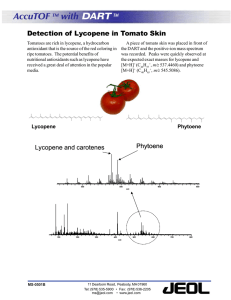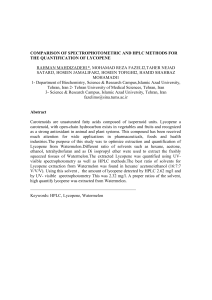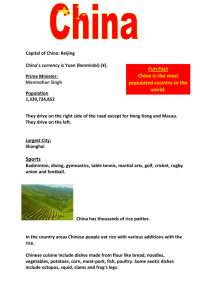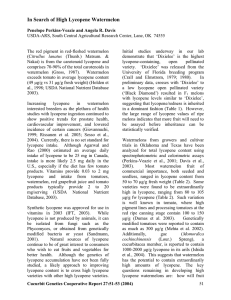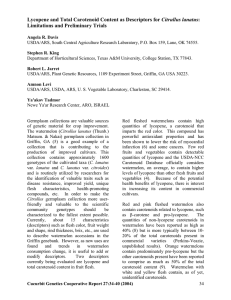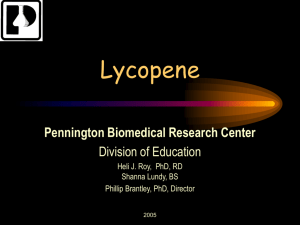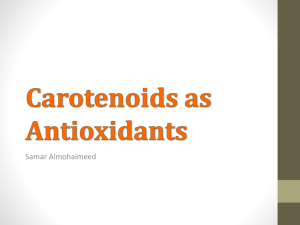Kameron
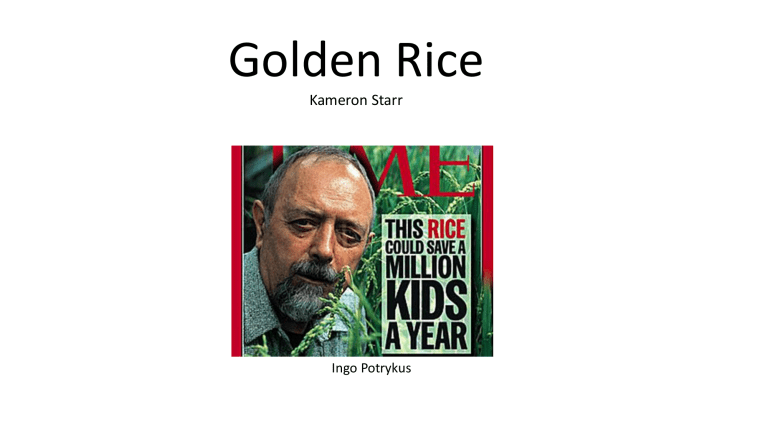
Golden Rice
Kameron Starr
Ingo Potrykus
Problem
• Many developing countries suffer from Vitamin A deficiency due to the predominant consumption of rice.
-Rice lacks Vitamin A and pro-vitamin A in the edible endosperm.
• This deficiency leads to blindness, especially in children
Problem
• Many developing countries suffer from Vitamin A deficiency due to the predominant consumption of rice.
-Rice lacks Vitamin A and pro-vitamin A in the edible endosperm.
• This deficiency leads to blindness, especially in children
Solution
• Genetically engineer rice to produce pro-vitamin A,
β-carotene.
Carotenoid
• organic pigment (red/orange/yellow color)
Chlorophyll dominating
Carotenoid dominating
Enzymes involved
1. IPP/DMAPP-Isomerase
2. GGPP-Synthase
3. Phytoene synthase (psy)
4. phytoene desaturase
5. ζ-carotene desaturase
6. lycopene –cyclase (lcy)
The Biosynthesis
Pathway
Catalyze introduction of two double bonds each
(shown on next slide) bacterial phytoene desaturase
(crtI)
Catalyze introduction of all 4 double bonds
Where did the foreign genes come from?
Daffodil (psy), (lcy) Erwinia uredovora (crtI)
The Biosynthesis Pathway
Ti plasmid-mediated gene transfer using
Agrobacterium tumafaciens
Recall:
Agrobacterium: Plant pathogen that delivers DNA to plants.
• Can be used in genetic engineering
- Delete the phytohormone genes
- Add cloning site for YFG
Single Transformation
• Initially this plasmid was used to insure that lycopene (red) was being synthesized.
• Contains genes for two enzymes
- Phytoene-Synthase (psy)
- Bacterial Phytoene Desaturase (crtI)
Co-Transformation
LB Gt1p psy nos! 35sp tp crtI nos! RB
• These plasmid were used to complete the synthesis of β-Carotene (Yellow)
• pZPsC is very similar to pB19hpc
- provides machinery for the synthesis of Lycopene
• pZLcyH was added to introduce Lycopene
β-Cyclase which should complete the pathway
SURPRISE!
• To the researcher’s surprise, the single transformation produced β-carotene without the accumulation of lycopene.
- α,β-cyclase may be constitutively expressed in endosperm
- formation of lycopene turns these genes on
• This makes transformation much more simple. Only two genes must be added.
• Pb19hpc was used and modified in the following two ways
- PMI selection replaced hygromycin
- nptII selectable marker removed
Modified pB19hpc
Results
• The transgene was inherited by offspring with a 3:1
Segregation, (Golden:WT)
• 1.6 μg carotenoid/g dry rice endosperm
- A child would need 3,330g(7.3lbs)/day
- Usually eat a max of 120g/day
• Proof of concept
Results
• Seed content analyzed by high performance liquid chromatography (HPLC)
• Co-transformants much more variable
• Lutein and zeaxanthin also synthesized\
-other carotenoids contributing to eye health
A.
Control seeds
B.
Single transformant
C.
Co-tranformant
D.
Co-transformant
• Psy was found to be the limiting factor
- hypothesis based on the lack of lycopene accumulation
• Psy genes from various other plants were used in an attempt to increase carotenoid synthesis. These include Maize, Pepper, and Tomato
• Maize yielded the best results
Golden Rice 2
Results
• The transgene was inherited by offspring with a 3:1
Segregation, (Golden:WT)
• 37 μg carotenoid/g dry rice endosperm
- A child would need 144g/day
- compares to the max of 120g/day
• Still no lycopene accumulation, further optimization possible
Controversy
• People are reluctant to consume this due to its genetic alteration
• Farmers fear this could contaminate WT rice
• Riots and “rice picking’s” have occurred
